机械工程英语翻译unit 1
- 格式:rtf
- 大小:63.17 KB
- 文档页数:13
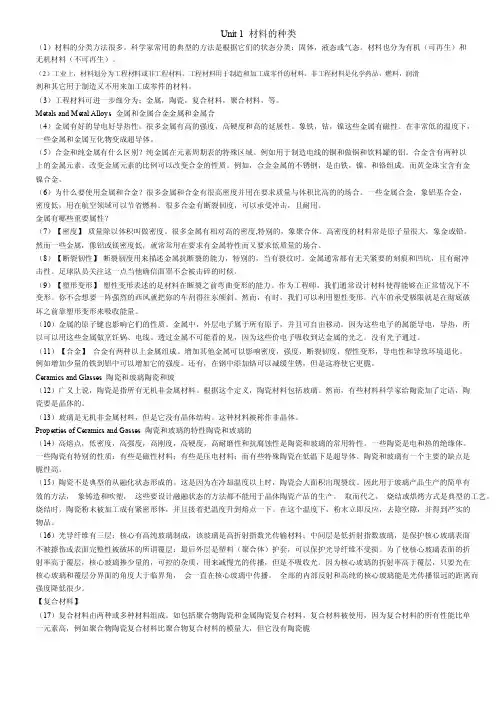
Unit 1 材料的种类(1)材料的分类方法很多。
科学家常用的典型的方法是根据它们的状态分类:固体,液态或气态。
材料也分为有机(可再生)和无机材料(不可再生)。
(2)工业上,材料划分为工程材料或非工程材料。
工程材料用于制造和加工成零件的材料。
非工程材料是化学药品,燃料,润滑剂和其它用于制造又不用来加工成零件的材料。
(3)工程材料可进一步细分为:金属,陶瓷,复合材料,聚合材料,等。
Metals and Metal Alloys 金属和金属合金金属和金属合(4)金属有好的导电好导热性,很多金属有高的强度,高硬度和高的延展性。
象铁,钴,镍这些金属有磁性。
在非常低的温度下,一些金属和金属互化物变成超导体。
(5)合金和纯金属有什么区别?纯金属在元素周期表的特殊区域。
例如用于制造电线的铜和做锅和饮料罐的铝。
合金含有两种以上的金属元素。
改变金属元素的比例可以改变合金的性质。
例如,合金金属的不锈钢,是由铁,镍,和铬组成。
而黄金珠宝含有金镍合金。
(6)为什么要使用金属和合金?很多金属和合金有很高密度并用在要求质量与体积比高的的场合。
一些金属合金,象铝基合金,密度低,用在航空领域可以节省燃料。
很多合金有断裂韧度,可以承受冲击,且耐用。
金属有哪些重要属性?(7)【密度】质量除以体积叫做密度。
很多金属有相对高的密度,特别的,象聚合体。
高密度的材料常是原子量很大,象金或铅。
然而一些金属,像铝或镁密度低,就常常用在要求有金属特性而又要求低质量的场合。
(8)【断裂韧性】断裂韧度用来描述金属抗断裂的能力,特别的,当有裂纹时。
金属通常都有无关紧要的刻痕和凹坑,且有耐冲击性。
足球队员关注这一点当他确信面罩不会被击碎的时候。
(9)【塑形变形】塑性变形表述的是材料在断裂之前弯曲变形的能力。
作为工程师,我们通常设计材料使得能够在正常情况下不变形。
你不会想要一阵强烈的西风就把你的车刮得往东倾斜。
然而,有时,我们可以利用塑性变形。
汽车的承受极限就是在彻底破坏之前靠塑形变形来吸收能量。
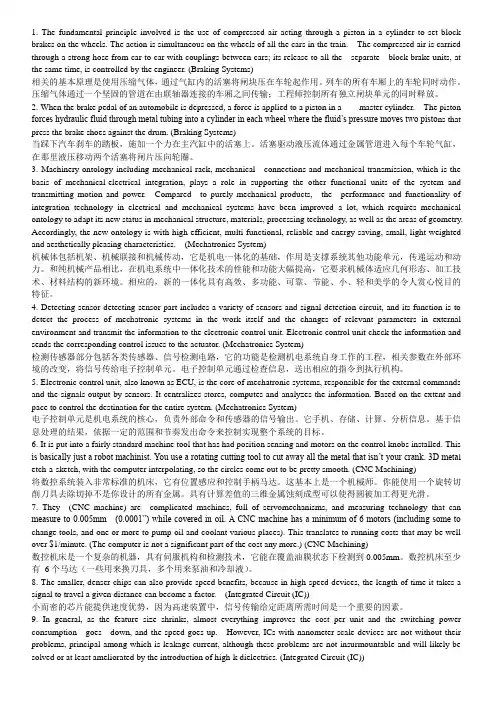
1. The fundamental principle involved is the use of compressed air acting through a piston in a cylinder to set block brakes on the wheels. The action is simultaneous on the wheels of all the cars in the train. The compressed air is carried through a strong hose from car to car with couplings between cars; its release to all the separate block brake units, at the same time, is controlled by the engineer. (Braking Systems)相关的基本原理是使用压缩气体,通过气缸内的活塞将闸块压在车轮起作用。
列车的所有车厢上的车轮同时动作。
压缩气体通过一个坚固的管道在由联轴器连接的车厢之间传输;工程师控制所有独立闸块单元的同时释放。
2. When the brake pedal of an automobile is depressed, a force is applied to a piston in a master cylinder. The piston forces hydraulic fluid through metal tubing into a cylinder in each wheel where the fluid’s pressure moves two pisto ns that press the brake shoes against the drum. (Braking Systems)当踩下汽车刹车的踏板,施加一个力在主汽缸中的活塞上。
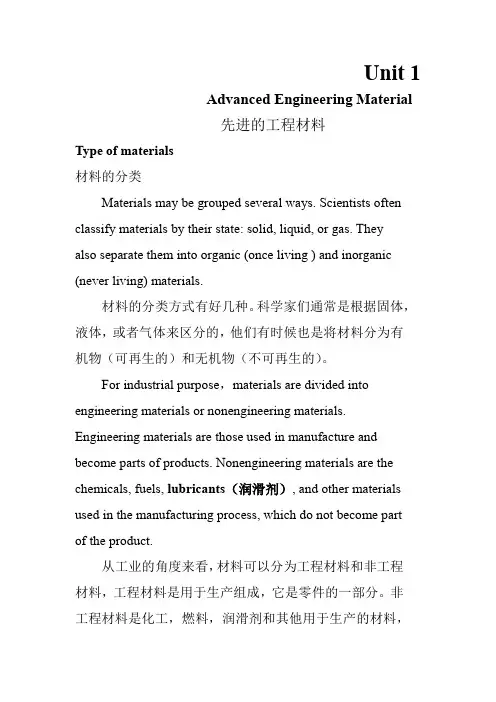
Unit 1Advanced Engineering Material先进的工程材料Type of materials材料的分类Materials may be grouped several ways. Scientists often classify materials by their state: solid, liquid, or gas. Theyalso separate them into organic (once living ) and inorganic (never living) materials.材料的分类方式有好几种。
科学家们通常是根据固体,液体,或者气体来区分的,他们有时候也是将材料分为有机物(可再生的)和无机物(不可再生的)。
For industrial purpose,materials are divided into engineering materials or nonengineering materials. Engineering materials are those used in manufacture and become parts of products. Nonengineering materials are the chemicals, fuels, lubricants(润滑剂), and other materials used in the manufacturing process, which do not become partof the product.从工业的角度来看,材料可以分为工程材料和非工程材料,工程材料是用于生产组成,它是零件的一部分。
非工程材料是化工,燃料,润滑剂和其他用于生产的材料,它们不是零件的组成部分。
Engineering materials may be further subdivided into:①Metals ②Ceramics(陶瓷)③Composite ④Polymers (高分子材料), etc.工程材料可进一步细化为1、金属。
![机械工程专业英语教程(第2版)[施平主编][翻译]_lesson1](https://uimg.taocdn.com/5728f673a417866fb84a8e09.webp)
Basic Concept in MechanicsThe branch of scientific analysis which deals with motions , time , and forces is called mechanics and is made up of two parts , statics and dynamics , Statics deals with the analysis of stationary systems , i.e. , those in which time is not a factor , and dynamics deals with systems which change with time .对运动、时间和作用力做出科学分析的分支称为力学。
它由静力学和动力学两部分组成。
静力学对静止系统进行分析,即在其中不考虑时间这个因素,动力学对随时间而变化的系统进行分析。
When a number of bodies are connected together to form a group or system , the forces of action and reaction between any two of the connecting bodies are called constraint forces . These forces constrain the bodies to behave in a specific manner . Forces external to this system of bodies are called applied forces .当一些物体连接在一起形成一个组合体或者系统时,任何两个相连接的物体之间的作用力和反作用力被称为约束力。
这些力约束着各个物体,使其处于特定的状态。
从外部施加到这个物体的系统的力被称为外力。
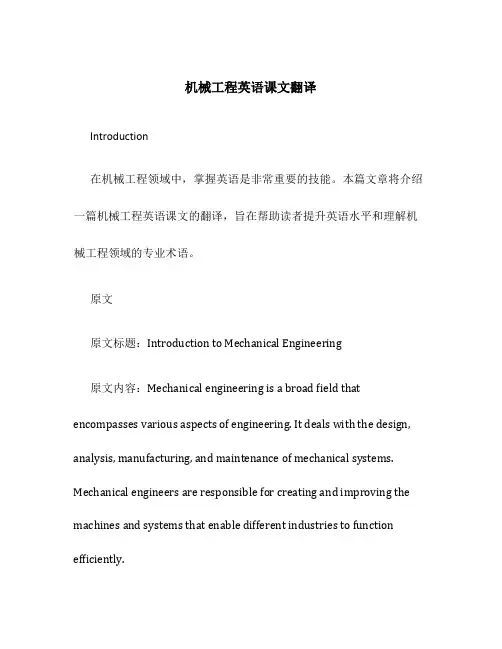
机械工程英语课文翻译Introduction在机械工程领域中,掌握英语是非常重要的技能。
本篇文章将介绍一篇机械工程英语课文的翻译,旨在帮助读者提升英语水平和理解机械工程领域的专业术语。
原文原文标题:Introduction to Mechanical Engineering原文内容:Mechanical engineering is a broad field that encompasses various aspects of engineering. It deals with the design, analysis, manufacturing, and maintenance of mechanical systems. Mechanical engineers are responsible for creating and improving the machines and systems that enable different industries to function efficiently.The field of mechanical engineering has a long history, dating back to ancient civilizations such as the Greeks and Egyptians. However, it wasn’t until the Industrial Revolution in the 18th century that mechanical engineering became a distinct discipline. This period saw the rise of factories and the need for efficient machines to drive industrial processes.Modern mechanical engineers work on a wide range of projects, from designing and constructing buildings to developing advanced robotics and aerospace systems. They utilize their knowledge of physics, mathematics, and materials science to analyze and solve complex engineering problems.翻译翻译标题:机械工程导论机械工程是一个包含各个工程学科的广泛领域。
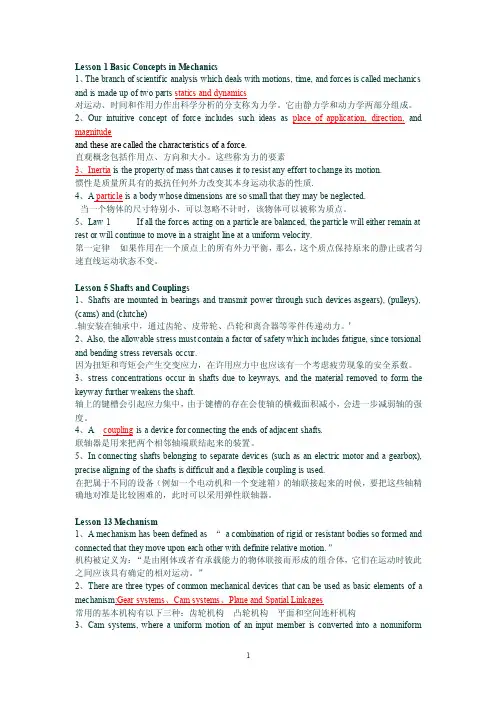
Lesson 1 Basic Concepts in Mechanics1、The branch of scientific analysis which deals with motions, time, and forces is called mechanics and is made up of two parts statics and dynamics对运动、时间和作用力作出科学分析的分支称为力学。
它由静力学和动力学两部分组成。
2、Our intuitive concept of force includes such ideas as place of application, direction,and magnitudeand these are called the characteristics of a force.直观概念包括作用点、方向和大小。
这些称为力的要素3、Inertia is the property of mass that causes it to resist any effort to change its motion.惯性是质量所具有的抵抗任何外力改变其本身运动状态的性质.4、A particle is a body whose dimensions are so small that they may be neglected.当一个物体的尺寸特别小,可以忽略不计时,该物体可以被称为质点。
5、Law 1 If all the forces acting on a particle are balanced, the particle will either remain at rest or will continue to move in a straight line at a uniform velocity.第一定律如果作用在一个质点上的所有外力平衡,那么,这个质点保持原来的静止或者匀速直线运动状态不变。
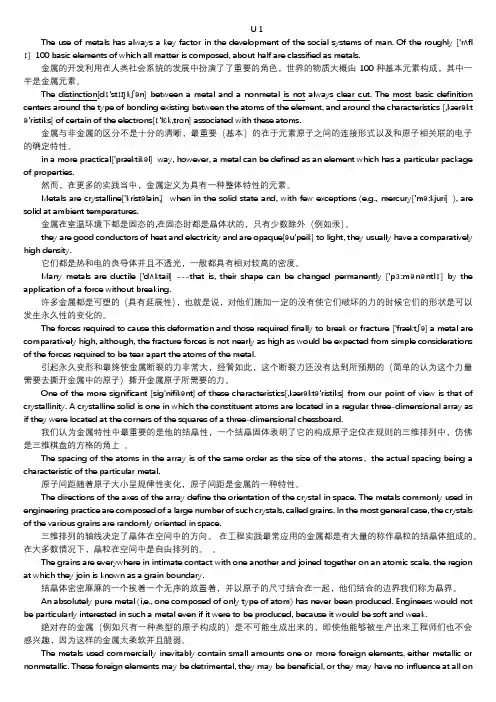
U 1The use of metals has always a key factor in the development of the social systems of man. Of the roughly ['rʌfl ɪ] 100 basic elements of which all matter is composed, about half are classified as metals.金属的开发利用在人类社会系统的发展中扮演了了重要的角色,世界的物质大概由100种基本元素构成,其中一半是金属元素。
The distinction[dɪ'stɪŋkʃən] between a metal and a nonmetal is not always clear cut. The most basic definition centers around the type of bonding existing between the atoms of the element, and around the characteristics [,kærəkt ə'ristiks] of certain of the electrons[ɪ'lɛk,trɑn] associated with these atoms.金属与非金属的区分不是十分的清晰,最重要(基本)的在于元素原子之间的连接形式以及和原子相关联的电子的确定特性。
in a more practical['præktikəl] way, however, a metal can be defined as an element which has a particular package of properties.然而,在更多的实践当中,金属定义为具有一种整体特性的元素。
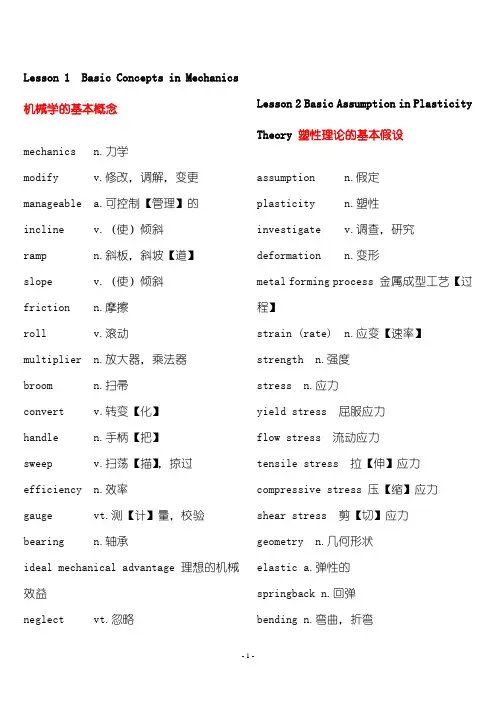
Lesson 1 Basic Concepts in Mechanics机械学的基本概念mechanics n.力学modify v.修改,调解,变更manageable a.可控制【管理】的incline v.(使)倾斜ramp n.斜板,斜坡【道】slope v.(使)倾斜friction n.摩擦roll v.滚动multiplier n.放大器,乘法器broom n.扫帚convert v.转变【化】handle n.手柄【把】sweep v.扫荡【描】,掠过efficiency n.效率gauge vt.测【计】量,校验bearing n.轴承ideal mechanical advantage 理想的机械效益neglect vt.忽略Lesson 2 Basic Assumption in Plasticity Theory 塑性理论的基本假设assumption n.假定plasticity n.塑性investigate v.调查,研究deformation n.变形metal forming process 金属成型工艺【过程】strain (rate) n.应变【速率】strength n.强度stress n.应力yield stress 屈服应力flow stress 流动应力tensile stress 拉【伸】应力compressive stress 压【缩】应力shear stress 剪【切】应力geometry n.几何形状elastic a.弹性的springback n.回弹bending n.弯曲,折弯precision forming 精密成型tolerance n.公差continuum n.连续(体)metallurgical a.冶金(学)的grain n.晶粒dislocation n.位错(uni-,tri-,multi-)axial a.(单,三,多)轴(向)的anisotropy n.各向异性cylindrical a.圆柱体的cross-section n.横截面platen n.(工作)台板,模板coincide with 一致,相符validity n.正确有效,合法with ease 轻(而)易(举)的,很容易的Lesson 3 Optimization for Finite Element Applications有限元优化的应用optimization n.优化,优选(法)finite element 有限元iterative a.反复的,迭代的alternative n.a.交替(的),可供选择的manual a.手动的,人工的trial-and-error 试凑法bias vt,n.(使)偏向【重、差】a desktop platform (计算机)桌面平台constrain(t) v,n.强制,约束response n.反【响】应,灵敏度parameter n.参数parametric a.参数的preprocess vt.预(先)加工,预处理mesh n,v.网格,啮合capability n.能力,性能,容量loop n.环,回路,循环pose v.提出model n.模型,样品displacement n.位移,排量,替换buckling n.弯【翘】曲,挠度factor n.因素gradient n.坡【梯】度,斜率flur n.【电,磁,热,光】通量,流量multidisciplinary a.多学科的deflection n.偏移【转,离】,挠曲Lesson 4 Metals 金属toughness n.韧性corrosion n.腐蚀dump v.倾倒,堆放recyle v.反复【循环】利用copper n.铜aluminum n.铝bronze n.青铜(器)alloy n.合金wear v.磨损metallic a.(含)金属(制)的specification n.操作规程,技术要求,说明书extract vt.提炼,萃取iron n.铁carbon n.碳ferrous a.(含)铁的ferrous metals 黑色金属lead n.铅zinc n.锌tin n.锡ore n.矿(石)mineral n,a.矿物(的)impurity n.杂质,不纯Lesson 5 Metallic and Nonmetallic Materials金属和非金属材料magnesium n.镁nickel n.镍brass n.黄铜luster n.光泽ductility n.延展性,可锻性it is likely that 很可能it is certain to (inf.)必然,一定density n.密度be distinguished from 与…区分coefficient n.系数in connection with 关于,与…相关【结合】category n.种类hardness n.硬度elasticity n.弹性beam n.横梁,一束(光)penetration n.贯穿,渗透abrasion n.磨损【耗】roll n,v.轧辊,滚,轧mill n.轧钢机,铣床spring n.弹簧permanent a.永久的rupture n.破【开】裂stamp n.冲压hammer n.(锻)锤Lesson 6 Plastics and Other Materials塑料和其他材料inorganic acid 无机酸sulphuric acid 硫酸hydrochloric acid 盐酸solvent n.溶剂carbon tetrachloride 四氯化碳rigid a,n.坚硬的,刚性(的),刚度mould(mold) n.模子,塑模,铸模decoration n.装饰fabricate vt.制造【备】,生产injection molding 注射模塑(法)blow molding 吹塑(法)compression molding 压塑(法),模压(法)extrusion n.挤压vacuum forming 真空模塑(法)powder metallurgy 粉末冶金constituent n,a.组成【的,部分】,组元simultaneously adv.同时subsequently adv.随后coherent a.互相凝聚的,协调一致的fusion n.熔化,熔接crystalline n,a.结晶【的】,晶体【的】restriction n.限制【定】,节流blend n,v.混合【物】,融合press n,v.压力机,压制homogeneous a.均匀的sinter n,vt.烧结【物】Lesson 7 Die Life and Die Failure模具的寿命和失效die n.模具,锻【冲】模,凹模die life 模具寿命die failure 模具损坏deterioration n.变坏,退化,损耗surface finish 表面光洁度breakdown n.破坏,击穿lubrication n.润滑cracking n.裂纹breakage n.断裂mode n.方式,状态,模式thermal fatigue 热疲劳layer n.层abrasive n,a.(研)磨料(的),磨损(的)impression n.模膛,型腔(槽)heat checking 热裂纹,龟裂steep n,a.陡(坡)的,急剧的reversal n.颠倒,相反overload n,v.(使)过【超】载initiation n.开【初】始,发【产】生discrete a.不连续的,单个的variable n.变量cavity n.模膛,型槽stock n.坯料,原材料impact n,v.冲击,碰撞Lesson 8 Cold Working and Hot Working 冷加工和热加工cold[hot] working 冷热加工forging n.锻造,锻件classification n.分类recrystallization n.再结晶take place 发生strain [deformation] hardening 应变【变形】硬化be referred to as 叫做,称为,被认为是warm working 温加工,温锻ultimate a,n.最终的,首要的,极限stress relieving 消除应力处理austenitic a.奥氏体的stainless steel 不锈钢annealing n.退火grain size 晶粒度solid solution 固溶体refinement n.精炼【制】,细化hazard n.危险,未知数,意外事件inherent a.固有的,先天的,本质的sensitive a.灵敏的,敏感的abnormal a.非正常的critical strain 临界应变Lesson 9 Casting 铸造casting n.铸造【件】die-casting n.模铸【件】foundry n.铸造【车间】pour v.浇注suitability n.适应性pig iron 生铁cupola n.冲天炉,化铁炉erosion n.腐蚀,(侵、烧)蚀ladle n.铁水包graphite n.石墨solidify v.(使)凝固disjoin v.拆散,分开ingot n.(钢)锭destructive a.破坏(性)的,有害的retard vt,n.(使)延缓,推迟solvent n,a.溶剂(的)copper-base alloy 铜基合金Lesson 10 Metal Forming Processes in Manufacturing 制造中的金属成形工艺machine-building 机械制造plastic working 塑性加工billet n 坯料,锻坯blank n.坯料,(冲压)板坯configuration n.外形,配置,排布stroke n.行程,冲程amortize v.阻尼,缓冲,分期偿还reliability n. 可靠性,安全性drawing n.(锻坯)拔长,【线,管材】拉拔deep drawing 深冲(压)brake forming 【压】折弯(机)成型stretch forming 张拉成型military n,a.军队【事,人】(的)consumer goods 消费品integrity n.完整性,完全(善)jet engine 喷气发动机turbine n.涡【汽】轮(机),透平(机)regarding 考虑到,关于Lesson 11 Forging锻造armor n.铠甲immortalize vt.(使)不朽(灭)blacksmith n.锻工mechanical press 机械压力机hydranlic press 液压机anvil n.(锤)砧,砧座craftsman n.技工handling n.处理,装卸,搬运flexibility n.柔(韧)性,灵活性drawn out 拔长upset n.镦粗,顶锻closed impression die 闭式模锻rapid-impact blow 快速冲击,猛打vertical a.立式的ram n.锤头,滑块,活动横梁block n.(模)块draft n.模锻斜度symmetrical a.轴对称的sizing n.整形,校正,定径drop forging 落锻,锤模锻impression die forging 模锻final forging 终锻overheat n.过热furnace n.【熔,高】炉pyrometer n.高温计Lesson 12 Benefits and Principles of Forging锻造的优点和工作原理metalworking n.金属压力加工knead v.揉搓【制】refine v.精炼【制】,细化porosity n.多孔性,疏松orient v.(使)定【取】向flow line 流线stress field 应力场manual skill 手工技巧at one’s command 自由使用,支配soundness n.致密性,坚固性,无缺陷attainable a.可达【得】到的open die forging 自由锻gross n.总共,重大confine vt. 限制,约束convert v.转变【换】,更换broken up 破【断】裂,分散microshrinkage n.显微缩孔elimination n.消除,淘汰align v.调整,对中,校直Lesson 13 Welding焊接weld(ing) v,n.焊接,熔焊pressurewelding 压力焊spotwelding 点焊buttwelding 对头(缝)焊fusionwelding 熔焊,熔接fiux-shielded arc welding 熔剂保护电弧焊diversity n.不同多样性fasten(ing) v,n.连接(件),紧固(件)shielding n.遮护,屏蔽solder(ing) v,n.软钎焊,(低温)焊料bismuth n.铋cadmium n.镉rivet n,v.铆钉,铆接braze n,vt.硬钎焊,铜焊oxidation n.氧化flux n.焊接,助溶剂squeeze v.挤压oxy-acetylene n,a.氧(乙)炔(的)torch n.焊炬electrode n.电(焊)极,焊条filler n.填充(剂)overlap v.搭接,重叠strike v.攻【打】击,放电Lesson 14 Heat Treatment热处理heat treatment 热处理microstructure n.显微组织low-carbon steel 低碳钢prescribe v.规定,指示microscopic a.显微的,微观的spheroidizing n.球化(处理)normalizing n.正火,(正)常化annealing n.退火hardening n.淬火tempering n.回火soaking(=holding) n.均热,保温retarding media 延缓介质prolonged a.长时间的,持续很久的critical temperature 临界温度globular a.球形(状)的carbide n.碳化物,硬质合金quenching n.淬火,骤冷removal n.除去,放出Lesson 15 Introduction to Mechanism机构介绍mechanism n.机械,机构,机构学kinematic a.=kinematical 运动的,运动学的kinematic chain 运动链link n.构件,杆件. v.连接【结】definite a.确定的constrained a.约束的,限定的unconstrained a.无约束的linkage n.连杆(组,机构)joint n.结【接】台,铰链. a.连接的,联合的pin n.销【钉】,铰销revolution v.旋转,转动. n.回转体prismatic a.棱柱(形)的nonlinear a.非线性的four-bar linkage 四杆机构kinematic chain 运动链prime mover 原动者【机】,驱动件coupler n.连接件,连杆pivot n.枢(轴),轴销,回转副,旋转中心configuration n.外形,构造,结构inversion n.转换,更换slider-crank mechanism 曲柄滑块机构multiloop n.多环链,a.多回路的sketch n.草【简,示意】图,v.画草图,草拟skeleton diagram 草图,示意图,简图envision v.想象binary a.二【双,复】的,二元的ternary a.三元的ternary links 三杆组quaternary a.四元的quaternary links 四杆组cam 凸轮cam follower n.凸轮从动件gear n.齿轮sprocket n.链轮belt n.【皮,布,钢】带pulley n.带轮spherical a.球的,球面的helical a.螺旋的three-dimensional 三维的,空间的intuitively adv.直觉【观】地synthesis n.合成(法),综合kinematician n.运动学研究者(家)innate a.先天的,固有的Lesson 16 Movement Analysis 运动分析criterion(pl.criteria) n.(判断)标准,判据,准则branch n,v.分(部,支)transmission angle 传动角rock n.摆动,v.摇动oscillate v.摆动,摇动parallelogram n.平行四边形antiparallelogram n.反平行四边形frame n.机架,构架impart v.给予,分给to impart M to N 把M给Ntorque n.力矩,扭矩dynamic a.=dynamical 动力的,动力学的inertia n.惯性(物),惯量static a.=statical 静力【学】的,静的index n.指数,指标friction n.摩擦thumb n.拇指,v.用拇指翻rule of thumb 根据经验和实际所得的做法matrix n.矩阵determinant n.行列式derivative n.导数derivative of M with respect to N M对于N的导数movability n.可动性,易动性parameter n.参数discount v.打折扣,忽视absolute a.绝对的graphical a.图形的,图解的polygon n.多边形theorem n.定理stress n.应力bearing n.轴承centripetal a.向心的Lesson 17 Kinematic Synthesis运动的综合packaging machinery 包装机械lubrication n.润滑specification n.技术要求actuation n.驱动jerk n.震动,冲击axis n.(pl.axes)轴【线,心】,中心线contour n.外形,轮廓线eccentricity n.偏心【度,率】gear ration 齿轮【速,齿数】比topologically adv.拓扑学地customary a.通常的,习惯的correlate v.使相关,使发生关系analog n.=analogue 类似(物),模拟linear analog 线性模拟second acceleration 二阶加速度higher acceleration 高阶加速度paraphrase v.释义,意译describe v.叙述,描述,作…运动category n.种类,类别deliberation n.慎重考虑province n.省,领域preconceive v.预想,事先想好analog computer 模拟计算机trace v.追踪,描画timing n.定时,计时,配时pitch v.投掷trajectory n.轨迹embed v.嵌入,夹在层间orientation n.(定)方位,(取)方向scoop n.勺子,铲斗,v.挖,掘,铲Lesson 18 Cams and Gears凸轮和齿轮cam n.凸轮gear n.齿轮curve n.曲线a.弯曲的groove n.槽,沟mate v.配合,啮合cylindrical a.圆柱的two-dimensional or planer 两维的或平面的three-dimensional or spatial 三维的或空间的normal n.法线a.垂直的complement n,a.余角,余的collinear a.共线的lateral a.横向的,侧向的stem n.杆guide n.导向件【器,装置】,导槽(座)intermittent a.间断的,不连续的dwell n,v.停止,小停顿inertial a.惯性的,惯量的engage v.啮合rack n.齿条noncircular a.非圆的conjugate a.共轭的,n.共轭值(线)cycloidal a.摆线的involved a.渐开线的,n.渐开线tolerance n.间隙,公差spur gear 直齿圆柱轮radial a.径向的,沿半径的offset n,vt.偏移,偏心a.偏心的disk cam 盘形凸轮tangent n.切线a.相切的,切线的concentric a.同圆(的),同心(的)camshaft n.凸轮轴pitch curve 节线herringbone a.人字形的intersect v.横穿,相交parallel helical gear斜齿轮,平行轴螺旋齿轮crossed helical gear 交错轴螺旋齿轮face gear 端面齿轮spiral bevel gear 螺旋齿圆锥齿轮worm n.蜗杆skew bevel 斜齿圆锥齿轮hypoid gear 准双曲面(直角交错轴双曲面)齿轮addendum (pl.addenda) n.齿顶,齿顶高project v.伸出,突出clearance n.间隙dedendum (pl. dedenda)n.齿根,齿根高tooth space 齿间距backlash n.间隙,齿隙Lesson 19 Screws, fasteners and joints螺纹件、紧固件和联接件screw n.螺钉,螺丝,v.旋紧,攻丝fastener n.紧固件joint n.连【联】接,接合bolt n.螺栓nut n.螺母cap screw 有头螺钉setscrew n.定位【固定,调整】螺钉rivet n.铆钉,v.用铆钉铆接key n.键weld n,v.焊接,熔焊braze n,v.钎焊,铜焊clip n.夹子,v.夹住,夹紧synonymous a.同意义的monotonous a.单调的taint n.污点,污染v.弄脏tough a.坚韧的ductile a.可延伸的,有延展性的,韧性的tighten v.上紧,拉紧twist v.扭转jumbo n.大型喷气式客机titanium n.钛close-tolerance 高精密度的tooling n.工具,刀具v.用刀具(切削)加工proliferate v.增殖,增殖assembly n.安装,装配,组件tap n.丝锥,v.攻螺丝stud n.双头螺栓resemble v.类似,像thread n.螺纹(线),v.车螺纹drill n,v.钻孔hexagon head 六角头fillister n.凹槽flat head 平头hexagon socket head 六角沉头disassemble v.拆开tensile a.拉【张】力的,受拉的shear n.剪切【力】v.剪切【断】harden v.使硬【化】washer n.垫圈preload n.预载荷fatigue n.疲劳micrometer n.千分尺,千分表elongation n.拉【伸】长modulus n.(pl.moduli)模数,模量wrench n.扳手dial n.刻度盘fractional a.分数的,小数的Lesson 21 Helical, Worm and Bevel Gears 斜齿轮、蜗杆蜗轮和锥齿轮helical gear 斜齿轮worm n.蜗杆,螺杆bevel gear 圆锥齿轮helix n,a.(pl. helices 或helixes)螺旋线,螺旋线的right hand 右手,右旋的helicoid n.a.螺旋【面,体】,螺旋(状,纹)的wrap v.缠绕unwind v.解开,展开generate v.产生,展成(加工)engagement n.啮合,接触diagonal n,a.对角线(的)objectionable a.该反对的,不能采用的spiral n,a. 螺旋线(的),卷线(的)spiral gear 螺旋齿轮mesh n.啮合worm gear 蜗轮pinion n.小齿轮pitch cylinder 节圆柱concave a.中凹的curvature a.曲率screw-like 像螺丝(杆)的thread n.线状物,螺纹线envelop v.包围,封闭enclose v.包围lead angle 导角cast v.铸造mill v.铣削outboard a,ad.外侧的,向外pronounced a.明确的,显著的stress n.应力tapered a.锥形的positively ad.确定地,强制(传动)地Pitch-line velocity 节线速度automobile differential 汽车差速器gearing n.齿轮传动(装置)offset n.偏置,横距hypoid a.准双曲面的hyperboloid n.双曲面,双曲面体Lesson 22 Shafts, Clutches and Brakes轴、离合器和制动器shaft n.轴clutch n.离合器brake n.制动器pulley n.(皮,胶)带轮flywheel n.飞轮sprocket n.链轮,星轮bending moment 弯曲力矩torsional a.扭转的static a.静(力,态)的axle n.心轴,轮轴spindle n.心轴,主轴deflection n.偏移,弯曲fillet n.圆角,倒角peening n.喷射(加工硬化法)shot peening 喷丸硬化stiff a.刚性的inertia n.惯性,惯量slippage n.滑动actuation n.驱动,开动coefficient n.系数statics n.静力学rim n.边缘,轮缘shoe n.闸瓦,制动片【块】band n.带,条cone n.圆锥miscellaneous a.(混)合的,杂项的assume v.假设,承担statical a.=static,静态的equilibrium n.平衡reaction n.反应,反力overload-release clutch 超载释放(保护)离合器magnetic fluid clutch 磁液离合器shift v.变换,(使)移动lever n.杆,(手)柄jaw n.颚板,夹爪ratchet n.棘轮circumferentiallyad v.周围地,圆周地mate v.配合,啮合,联接synchronous a.同步的linear drive 线性驱动装置clicking n.‘卡塔’声freewheel v.空转coupling n.联轴器sleeve n.套筒flat n.平面(部分)a.平的periphery n.圆周,周边wedge n.楔(形物)v.楔入pawl n.棘爪powder n.粉末mixture n.混合物electromagnetic a.电磁的coil n.线圈excitation n.刺激,激励shearing a.剪切的lockup n.锁住Lesson 41 Definition of Robotics and the Robot Systemmanipulator n.操作器,控制器,机械手peripheral a.周围的,外围的idiot n.白痴integrate v.使成为一体,使结合起来hard automation 刚性自动化a host of 许多Lesson 42 Basics of Computers(I)execute v.执行binary a.二进制的read only memory (ROM) 只读存储器random access memory (RAM)读写存储器,随机存储器erasable a.可擦去的volatile a.可丢失的Lesson 43 Basics of Computers(二)harsh a.恶劣的robust a.稳定的configuration n.结构,组态Morse Code 莫尔斯电码suffice v.足够interference n.干扰fluctuation n.脉动,波动expendable a.可消耗的intermediate a.中间的adaptor n.转换器transformer n.变压器rectifier n.整流器capacitor n.电容器Zener diode 齐纳(稳压)二极管buffer n.缓冲寄存器come across 碰到Baud rate 波特率Lesson 44 Programmable Controllersalbeit conj.虽然light-emitting diodes 发光二极管relay ladder logic 继电器梯形逻辑图archaically a.古体的,旧式的retention n.保留,保持versed a.熟练的,精通的fluidics n.射流sheer a.完全的,绝对的profligate a.浪费的proprietary a.专利的,专有的boolean expression 布尔表达式Lesson 45 CAD/CAMComputed-aided design(CAD) n.计算机辅助设计Computed-aided manufacturing(CAM) n.计算机辅助制造automatic factory n.自动化工厂drafting n.制图Computer-aided engineering n.计算机辅助工程management information systems n.管理信息系统graphics terminal n.图像终端a shared data base n.公用数据库three-dimensional a.三维的keyboard n.键盘lightpen=light pen n.光笔magnify v.放大flip v,n.翻转copy v.拷贝a mirror image 镜像symmetrical a.对称的artwork n.印刷线路原图Geometric modeling n.几何模型制造kinematics n.运动学Lesson 48 Flexible Manufacturing Systemsfexible manufacturing systems(FMS)柔性制造系统flexible manufacturing celles(FMC) 柔性制造单元automated guided vehicles 自动搬运小车conveyor n.传送装置pallet loading and unloading carts 上下料小车part program 零件程序data base 数据库data processing networks 数据处理网络inspection program 检测程序robot program 自动机程序real-time control data 实时控制数据the Control hierarchy 控制层次real-time fault recovery 实时故障恢复unmanned operation 无人化操作chip removel 排屑module n.模块,组件intelligent node智能节点。
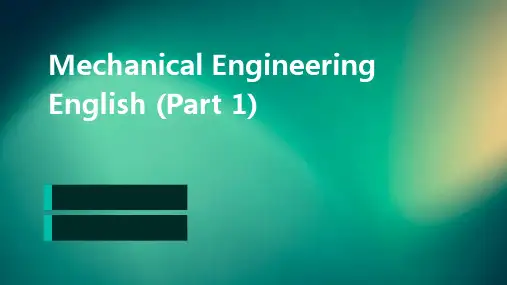
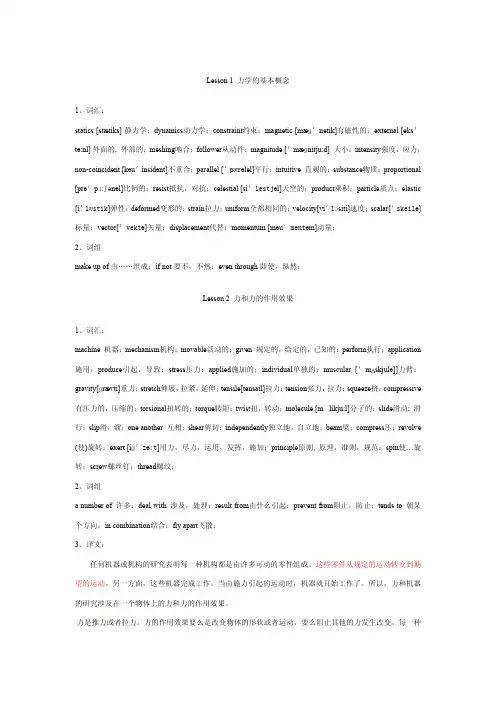
Lesson 1 力学的基本概念1、词汇:statics [stætiks] 静力学;dynamics动力学;constraint约束;magnetic [mæɡ'netik]有磁性的;external [eks'tə:nl] 外面的, 外部的;meshing啮合;follower从动件;magnitude ['mæɡnitju:d] 大小;intensity强度,应力;non-coincident [kəu'insidənt]不重合;parallel ['pærəlel]平行;intuitive 直观的;substance物质;proportional [prə'pɔ:ʃənəl]比例的;resist抵抗,对抗;celestial [si'lestjəl]天空的;product乘积;particle质点;elastic [i'læstik]弹性;deformed变形的;strain拉力;uniform全都相同的;velocity[vi'lɔsiti]速度;scalar['skeilə]标量;vector['vektə]矢量;displacement代替;momentum [məu'mentəm]动量;2、词组make up of由……组成;if not要不,不然;even through即使,纵然;Lesson 2 力和力的作用效果1、词汇:machine 机器;mechanism机构;movable活动的;given 规定的,给定的,已知的;perform执行;application 施用;produce引起,导致;stress压力;applied施加的;individual单独的;muscular ['mʌskjulə]]力臂;gravity[ɡrævti]重力;stretch伸展,拉紧,延伸;tensile[tensail]拉力;tension张力,拉力;squeeze挤;compressive 有压力的,压缩的;torsional扭转的;torque转矩;twist扭,转动;molecule [m likju:l]分子的;slide滑动; 滑行;slip滑,溜;one another 互相;shear剪切;independently独立地,自立地;beam梁;compress压;revolve (使)旋转;exert [iɡ'zə:t]用力,尽力,运用,发挥,施加;principle原则, 原理,准则,规范;spin使…旋转;screw螺丝钉;thread螺纹;2、词组a number of 许多;deal with 涉及,处理;result from由什么引起;prevent from阻止,防止;tends to 朝某个方向;in combination结合;fly apart飞散;3、译文:任何机器或机构的研究表明每一种机构都是由许多可动的零件组成。

Lesson 1 Basic Concepts in Mechanics The branch of scientific analysis which deals with motions, time, and forces is called mechanics and is made up of two parts, statics and dynamics. Statics deals with the analysis of stationary systems, i.e., those in which time is not a factor, and dynamics deals with systems which change with time.对运动、时间和作用力进行科学分析的分支称为力学。
它由静力学和动力学两部分组成。
静力学对静止系统进行分析,即在其中不考虑时间这个因素,动力学对随时间而变化的系统进行分析。
Forces are transmitted into machine members through mating surfaces, e. g., from a gear to a shaft or from one gear through meshing teeth to another gear, from a V belt to a pulley, or from a cam to a follower. It is necessary to know the magnitudes of these forces for a variety of reasons. The distribution of the forces at the boundaries or mating surfaces must be reasonable, and their intensities must be within the working limits of the materials composing the surfaces. For example, if the force operating on a journal bearing becomes too high, it will squeeze out the oil film and cause metal-to-metal contact, overheating, and rapid failure of the bearing. If the forces between gear teeth are too large, the oil film may be squeezed out from between them. This could result in flaking and spalling of the metal, noise, rough motion, and eventual failure. In the study of mechanics we are principally interested in determining the magnitude, direction, and location of the forces.力通过接触表面传到机器中的各构件上。
机械工程专业英语唐一平翻译第一篇:机械工程专业英语唐一平翻译Unit1 1.2Ferrous Metals and Alloys By virtue of their wide range of mechanical, physical, and chemical properties, ferrous metals and alloys are among the most useful of all metals.Ferrous metals and alloys contain iron as their base metal: the general categories are cast irons, carbon and alloy steels, stainless steels, tool and die steels.1.2黑色金属及其合金:由于它们的一系列广泛的机械物理和化学的特征,黑色金属及其合金是所有金属中最有用的铁是黑色金属及其合金中的基本元素主要种类有铸铁,碳钢,合金钢,不锈钢,工具钢和磨具钢The term cast iron refers to a family of ferrous alloys composed of iron, carbon(ranging from 2.11% to about 4.5%),and silicon(up to about 3.5%).Cast irons are usually classified as follows: 1.Gray cast iron,or gray iron;2.Ductile cast iron, nodular cast iron, or spherical graphite cast iron;3.White cast iron;4.Malleable iron;pacted graphite iron。
Unit11.2Ferrou s Metals and AlloysBy virtueof their wide range of mechani c al, physical, and chemical properties, ferrous metalsand alloysare among the most useful o f all metals. Ferrous metalsand alloyscontain iron as their base metal: the general categori es are cast irons, carbonand alloy steels, stainle ss steels, tool and die steels.1.2黑色金属及其合金:由于它们的一系列广泛的机械物理和化学的特征,黑色金属及其合金是所有金属中最有用的铁是黑色金属及其合金中的基本元素主要种类有铸铁,碳钢,合金钢,不锈钢,工具钢和磨具钢The term cast iron refersto a familyof ferrous alloys compose d of iron, carbon(rangi ng from 2.11% to about 4.5%),and silicon(up to about 3.5%).Cast irons are usually classifi ed as follows:1.Gray cast iron,or gray iron;2.Ductile cast iron, nodular cast iron, or spherical graphit e cast iron;3.White cast iron;4.Malleabl e iron;pact ed graphit e iron。
机械工程专业英语教程第一课:机械工程简介Introduction to Mechanical EngineeringSection 1: OverviewMechanical engineering is a diverse and dynamic field that encompasses the design, development, and operation of machinery, structures, and systems. This branch of engineering plays a crucial role in various industries, including automotive, aerospace, manufacturing, and energy.Section 2: Responsibilities and SkillsAs a mechanical engineer, your responsibilities will include designing and analyzing mechanical systems, conducting tests and experiments, and supervising the manufacturing process. You will also need to have a strong understanding of physics, mathematics, and computer-aided design (CAD). Additionally, problem-solving skills, attention to detail, and the ability to work well in teams are essential.Section 3: Career OpportunitiesA degree in mechanical engineering can open up a wide range of career opportunities. You could work in research and development, product design, manufacturing, or projectmanagement. Mechanical engineers are in demand in almost every industry, ensuring a stable and rewarding career path.Section 4: University CoursesTo become a mechanical engineer, it is essential to pursue a degree in mechanical engineering from a reputable university. The curriculum typically includes courses in engineering principles, materials science, thermodynamics, fluid mechanics, and mechanical design. Additionally, practical training through internships or cooperative education programs is crucial for gaining hands-on experience.Section 5: ConclusionMechanical engineering offers a challenging and rewarding career for those with a passion for solving problems and a desire to create innovative solutions. With the right education and skills, you can embark on a successful journey in the field of mechanical engineering. Remember, the possibilities are endless in this ever-evolving discipline.第二课:机械设计基础Fundamentals of Mechanical DesignSection 1: IntroductionIn this lesson, we will explore the fundamentals of mechanical design. Mechanical design involves the creation and development of physical systems and components that meet specific requirements and specifications. This processrequires a deep understanding of materials, mechanics, and engineering principles.Section 2: Design ProcessThe design process typically follows a systematic approach that includes several stages. These stages include problem identification, conceptual design, detailed design, manufacturing, and testing. Each stage involves various activities such as brainstorming, prototyping, and evaluation.Section 3: Design ConsiderationsDuring the design process, there are several important considerations to keep in mind. These include functionality, efficiency, reliability, safety, and cost-effectiveness. It is also crucial to consider the environmental impact and sustainability of the design.Section 4: Tools and SoftwareTo aid in the design process, engineers use various tools and software. Computer-aided design (CAD) software allows for precise modeling and simulation of mechanical systems. Finite element analysis (FEA) software helps in analyzing the structural integrity and performance of designs.Section 5: Case StudyTo further understand the application of mechanical design principles, we will examine a case study. This real-world example will demonstrate how the design process isimplemented to solve a specific problem and achieve desired outcomes.Section 6: ConclusionMechanical design is a critical aspect of mechanical engineering. It requires a combination of creativity, technical knowledge, and attention to detail. By mastering the fundamentals of mechanical design, you will be well-equippedto tackle complex challenges and contribute to the development of innovative solutions.以上是《机械工程专业英语教程》的课文翻译。
LESSON 1 Classification of Engineering MaterialsNonferrous Metal elements other than iron called nonferrous metals.有色金属元素和像铁一样的有色金属不同。
The nonferrous subgroup includes common lightweight metals such as titanium and beryllium and common heavier metals such as copper, lead, tin and zinc.有色金属包括常用的轻金属,比如钛和铍,还有常见的重金属比如铜,铅,锡和锌。
Among the heavier metals is a group of white metals, including tin, lead, and cadmium; they have lower melting, about 230 to 330.在常用的重金属中,比如锡,铅和镉。
它们的熔点较低,一般是230到330摄氏度。
Among the high temperature nonferrous metals are molybdenum, niobium, tantalum, and tungsten. 高温有色金属包括钼,铌,钽和钨。
Tungsten has the highest melting of all metals: 3400 centigrade. Metal alloys other than iron are called nonferrous alloys are practically endless.钨在所有金属中具有最高的熔点,达到了3400摄氏度。
事实上金属合金远不同于有色金属合金。
Powdered Metals alloying of metals involves melting the main ingredients together so that on cooling, the metal alloy is generally a nonporous solid.粉末合金金属是通过熔化主要金属元素并结合在一起,然后让他们冷却而形成的,金属合金一般是无孔隙固体。
Types of Materials材料的类型Materials may be grouped in several ways. Scientists often classify materials by their state: solid, liquid, or gas. They also separate them into organic (once living) and inorganic (never living) materials.材料可以按多种方法分类。
科学家常根据状态将材料分为:固体、液体或气体。
他们也把材料分为有机材料(曾经有生命的)和无机材料(从未有生命的)。
For industrial purposes, materials are divided into engineering materials or nonengineering materials. Engineering materials are those used in manufacture and become parts of products.就工业效用而言,材料被分为工程材料和非工程材料。
那些用于加工制造并成为产品组成部分的就是工程材料。
Nonengineering materials are the chemicals, fuels, lubricants, and other materials used in the manufacturing process, which do not become part of the product.非工程材料则是化学品、燃料、润滑剂以及其它用于加工制造过程但不成为产品组成部分的材料。
Engineering materials may be further subdivided into: ①Metal ②Ceramics ③Composite ④Polymers, etc.工程材料还能进一步细分为:①金属材料②陶瓷材料③复合材料④聚合材料,等等。
Metals and Metal Alloys金属和金属合金Metals are elements that generally have good electrical and thermal conductivity. Many metals have highstrength, high stiffness, and have good ductility.金属就是通常具有良好导电性和导热性的元素。
许多金属具有高强度、高硬度以及良好的延展性。
Some metals, such as iron, cobalt and nickel, are magnetic. At low temperatures, some metals and intermetallic compounds become superconductors.某些金属能被磁化,例如铁、钴和镍。
在极低的温度下,某些金属和金属化合物能转变成超导体。
What is the difference between an alloy and a pure metal? Pure metals are elements which come from a particular area of the periodic table. Examples of pure metals include copper in electrical wires and aluminum in cooking foil and beverage cans.合金与纯金属的区别是什么?纯金属是在元素周期表中占据特定位置的元素。
例如电线中的铜和制造烹饪箔及饮料罐的铝。
Alloys contain more than one metallic element. Their properties can be changed by changing the elements present in the alloy. Examples of metal alloys include stainless steel which is an alloy of iron, nickel, and chromium; and gold jewelry which usually contains an alloy of gold and nickel.合金包含不止一种金属元素。
合金的性质能通过改变其中存在的元素而改变。
金属合金的例子有:不锈钢是一种铁、镍、铬的合金,以及金饰品通常含有金镍合金。
Why are metals and alloys used? Many metals and alloys have high densities and are used in applications which require a high mass-to-volume ratio.为什么要使用金属和合金?许多金属和合金具有高密度,因此被用在需要较高质量体积比的场合。
Some metal alloys, such as those based on aluminum, have low densities and are used in aerospace applications for fuel economy. Many alloys also have high fracture toughness, which means they can withstand impact and are durable.某些金属合金,例如铝基合金,其密度低,可用于航空航天以节约燃料。
许多合金还具有高断裂韧性,这意味着它们能经得起冲击并且是耐用的。
What are some important properties of metals?Density is defined as a material’s mass divided by its volume. Most metals have relatively high densities, especially compared to polymers.金属有哪些重要特性?密度定义为材料的质量与其体积之比。
大多数金属密度相对较高,尤其是和聚合物相比较而言。
Materials with high densities often contain atoms with high atomic numbers, such as gold or lead. However, some metals such as aluminum or magnesium have low densities, and are used in applications that require other metallic properties but also require low weight.高密度材料通常由较大原子序数原子构成,例如金和铅。
然而,诸如铝和镁之类的一些金属则具有低密度,并被用于既需要金属特性又要求重量轻的场合。
Fracture toughness can be described as a material’s ability to avoid fracture, especially when a flaw isintroduced. Metals can generally contain nicks and dents without weakening very much, and are impact resistant. A football player counts on this when he trusts that his facemask won’t shatter.断裂韧性可以描述为材料防止断裂特别是出现缺陷时不断裂的能力。
金属一般能在有缺口和凹痕的情况下不显著削弱,并且能抵抗冲击。
橄榄球运动员据此相信他的面罩不会裂成碎片。
Plastic deformation is the ability of bend or deform before breaking. As engineers, we usually design materials so that they don’t deform under normal conditions. You don’t want your car to lean to the east after a strong west wind.塑性变形就是在断裂前弯曲或变形的能力。
作为工程师,设计时通常要使材料在正常条件下不变形。
没有人愿意一阵强烈的西风过后自己的汽车向东倾斜。
However, sometimes we can take advantage of plastic deformation. The crumple zones in a car absorb energy by undergoing plastic deformation before they break.然而,有时我们也能利用塑性变形。
汽车上压皱的区域在它们断裂前通过经历塑性变形来吸收能量。
The atomic bonding of metals also affects their properties. In metals, the outer valence electrons are shared among all atoms, and are free to travel everywhere. Since electrons conduct heat and electricity, metals make good cooking pans and electrical wires.金属的原子连结对它们的特性也有影响。
在金属内部,原子的外层阶电子由所有原子共享并能到处自由移动。
由于电子能导热和导电,所以用金属可以制造好的烹饪锅和电线。
It is impossible to see through metals, since these valence electrons absorb any photons of light which reach the metal. No photons pass through.因为这些阶电子吸收到达金属的光子,所以透过金属不可能看得见。
没有光子能通过金属。
Alloys are compounds consisting of more than one metal. Adding other metals can affect the density, strength, fracture toughness, plastic deformation, electrical conductivity and environmental degradation.合金是由一种以上金属组成的混合物。